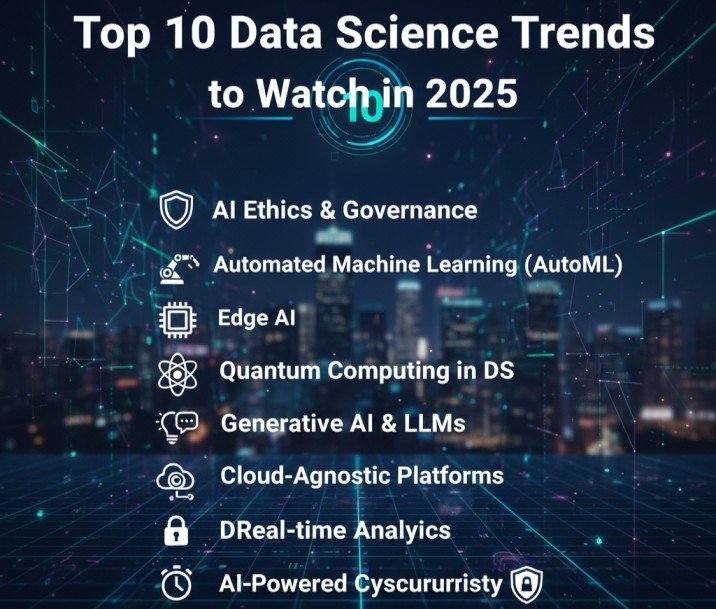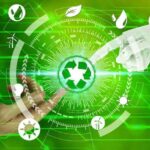As we step into 2025, data science continues to be a driving force behind innovation, shaping industries and transforming businesses. With rapid technological advancements and growing reliance on data-driven decisions, new trends are emerging in the field. These trends not only redefine the capabilities of data science but also open doors to exciting opportunities for organizations and professionals alike. Here are the top 10 data science trends to watch in 2025.
1. Rise of Explainable AI (XAI)
As artificial intelligence (AI) becomes more integrated into decision-making, transparency is critical. Explainable AI focuses on making machine learning models more interpretable, ensuring stakeholders understand how decisions are made. In industries like healthcare and finance, XAI will play a pivotal role in fostering trust and accountability.
2. Edge AI and Real-Time Analytics
The proliferation of IoT devices has paved the way for edge AI, where data is processed closer to the source rather than in centralized servers. This trend enhances real-time decision-making, reduces latency, and supports applications like autonomous vehicles, smart cities, and predictive maintenance.
3. Automated Machine Learning (AutoML)
AutoML is simplifying the machine learning workflow by automating tasks such as data preprocessing, feature selection, and model tuning. This trend empowers non-experts to leverage machine learning capabilities, accelerating innovation and democratizing data science.
4. Data-Centric AI
The focus is shifting from creating complex models to improving data quality. Data-centric AI emphasizes cleaning, labeling, and curating datasets to enhance model performance. This approach ensures that machine learning models are built on robust and reliable data.
5. AI for Sustainability
Sustainability is a global priority, and data science is stepping up to address environmental challenges. Predictive models are being used to optimize energy consumption, monitor climate change, and enhance resource management. Green AI, which focuses on reducing the carbon footprint of AI systems, is gaining traction.
6. Synthetic Data Generation
As data privacy concerns grow, synthetic data generation is emerging as a solution. By creating artificial datasets that mimic real-world data, organizations can protect user privacy while enabling robust model training. This trend is particularly relevant in sectors like healthcare and finance.
7. Natural Language Processing (NLP) Evolution
NLP is advancing rapidly, enabling machines to understand and generate human language with greater accuracy. In 2025, expect more sophisticated applications, such as real-time language translation, conversational AI, and automated content creation, driven by large language models.
8. Quantum Computing in Data Science
Quantum computing is set to revolutionize data science by solving complex problems that are currently infeasible for classical computers. In fields like cryptography, optimization, and drug discovery, quantum algorithms will unlock new possibilities.
9. DataOps and MLOps Integration
The integration of DataOps (data operations) and MLOps (machine learning operations) streamlines the deployment of data science solutions. These practices ensure efficient collaboration, continuous integration, and faster deployment of models, enhancing scalability and reliability.
10. Hyper-Personalization with AI
Hyper-personalization leverages AI and data science to deliver tailored experiences to individual users. From e-commerce to entertainment, businesses will use predictive analytics to anticipate user needs and preferences, enhancing customer satisfaction and loyalty.
Implications for Businesses
Staying ahead in the data-driven world requires organizations to embrace these trends. Here are some actionable steps businesses can take:
- Invest in Emerging Technologies: Adopt tools and platforms that align with the latest data science advancements.
- Focus on Ethical AI: Prioritize transparency, fairness, and accountability in AI implementations.
- Upskill Teams: Provide training in cutting-edge techniques like AutoML, NLP, and quantum computing.
- Leverage Data Strategically: Ensure data quality and adopt a data-centric approach for better decision-making.
Conclusion
The future of data science in 2025 is brimming with possibilities. From explainable AI and quantum computing to sustainability and hyper-personalization, these trends will shape how businesses operate and innovate. By keeping a close eye on these developments and adapting proactively, organizations can harness the power of data science to thrive in an increasingly competitive and dynamic environment.
Embrace these trends, and let data science drive your journey toward success in 2025 and beyond!









